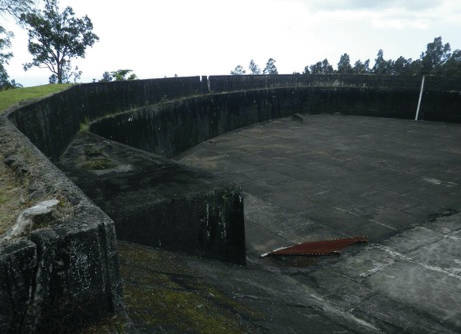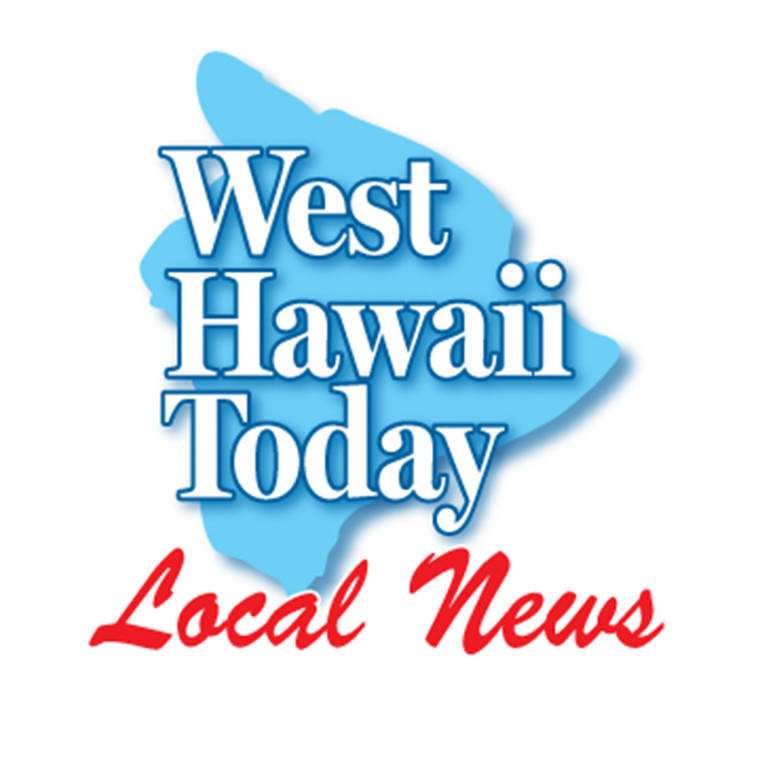BLNR fines Ka‘u dam owner: Edmund C. Olson Trust ordered to pay $7,500 for unaddressed deficiencies

The Board of Land and Natural Resources Friday fined the Edmund C. Olson Trust, owner of the Keaiwa Reservoir above Pahala, seen in this 2014 photo, for failure to comply with a notice of deficiency issued in February 2020. (Image from DLNR staff submittal/Special to West Hawaii Today)

The Board of Land and Natural Resources Friday fined the Edmund C. Olson Trust, owner of the Keaiwa Reservoir above Pahala, for failure to comply with a notice of deficiency issued in February 2020.
The Board of Land and Natural Resources Friday fined the Edmund C. Olson Trust, owner of the Keaiwa Reservoir above Pahala, for failure to comply with a notice of deficiency issued in February 2020.
Built in 1920, the Keaiwa Reservoir has a concrete-lined earth embankment with concrete parapet wall extension on the crest. The off-stream structure receives water from the Ka‘ala‘ala and Noguchi tunnels via PVC piping installed by the trust. Though it has been empty since about 2010, the 32-foot reservoir located at 3,100 feet in elevation has a capacity of 48 acre feet, or about 16 million gallons.
The reservoir is currently classified as being a low hazard potential dam, although the Department of Land and Natural Resources recommended the trust verify that finding made in 2008 because there are structures, including the Ka‘u Coffee Mill, that have been added downslope, within the reservoir’s inundation area.
Though a low hazard for probable loss of life and environmental and economic loss exists, DLNR Engineer Carty S. Chang told board members the dam’s condition is “unsatisfactory, which is the worst condition category.” It has been inspected seven times since 2006, when the Dam Safety Program was implemented in the wake of the deadly Kaloko dam breach on Kauai.
According to the staff submittal, the Keaiwa Reservoir’s embankment has experienced numerous seismic events and its concrete parapet wall is cracked in several locations; the spillway needs to be evaluated to ensure it can pass the maximum design flood; investigation is needed into the outlet works for possible seismic damage; and uncertainties regarding the concrete liner and embankment.
The department issued its first enforcement action in August 2016 via a notice of deficiency indicating the dam was in “poor condition and posed a threat to public safety due to one or more physical/operational conditions and deficiencies” that were noted in previous inspection reports. The 2016 notice specifically required the reservoir be drained, a remediation schedule be submitted, emergency action plan be updated and monthly monitoring reports be submitted.
Thereafter, the trust remained in compliance with keeping the reservoir empty, has submitted monthly monitoring reports and updated its emergency action plan. It did not provide a remediation schedule, however.
The next notice of deficiency was issued in February 2020. It outlined reservoir wall damage from an earthquake and that the spillway may not be able to pass the probable maximum flood.
That notice stipulated six deadlines for the trust, including requiring the trust contract with a consultant to complete engineering evaluation of the deficiencies by June 1, 2020; install a water level monitoring system by May 30, 2020; submit technical studies by June 30, 2020; submit a dam safety permit application by June 30 of this year; start construction by June 30, 2022; and to maintain the reservoir being empty and submit monthly monitoring reports.
According to the staff submittal, the trust hired consultant SSFM International on Jan. 25, but did not install the water level monitoring system. Technical studies have also not been submitted and the permit application is pending.
The staff recommended the trust not be fined for missing the deadline to hire a consultant because the owner “is taking proactive steps to get on a remediation schedule,” but proposed a $10,000 fine for failing to submit the technical studies and a $5,000 fine for failing to install the water level monitoring system.
Further, staff recommended the trust install no later than July 1 the water level monitoring system, and by Aug. 1 submit the technical studies to include a topography map, hydrologic/hydraulic studies, stability analyses, and other application reports to support proposed improvements. Conceptual plans and a project timeline through construction completion would be due by Dec. 1. By June 1, 2022, the trust must submit a dam safety permit application, followed by submitting proof of hiring a contractor for the project. Construction would have to commence by June 1, 2023.
“We believe this is a reasonable schedule moving forward,” said Carty.
Trust Chief Operating officer Jeff Clark said when the trust received the February 2020 notice, it called the DLNR to discuss the findings, and then tendered a letter with the trust’s input, including pushing back on the need for a water level monitoring system. The trust, he said, didn’t hear back from DLNR until June, at which point the department provided no confirmation or rejection of the trust’s requests.
“So we continued to be in a state of flux in terms of what the requirements and, of course, today we are being fined for not complying with that letter in a timely fashion, which happened to be right smack dab in the middle of that pandemic lockdown,” he said.
The next communication with the department came in December via a phone call, and the trust has been working to meet the requirements, including hiring the consultant in January. Clark said the water level monitoring system is nearing installation though a “few technical hurdles” associated with power and internet are being worked out.
“We’re working proactively. What I think happened is the pandemic got in the way there. It’s not that we had a desire not to comply with the DLNR’s request. The reality of life is that the pandemic hit and we didn’t receive any communication back and we were stuck in the middle, in a state of flux,” Clark said. “Once we had that conversation with DLNR in December, we’ve stuck to what we’ve committed to and we’re moving forward with deciding on whether we’re going to decommission the dam, deregulate the dam or whatever.”
He said the trust was “disappointed” with the proposed fines, noting the trust was moving forward despite the pandemic and lockdowns.
“We think the fines are a bit unnecessary given the fact we are moving forward and we always had the intention of moving forward,” he said. “The pandemic got in the way.”
He added, “The last thing we want is for this to be a safety hazard. that’s just not what were about. We’re about community, we’re about development, we’re about sustainability. We’re not about getting people injured and having a problem. As soon as we were able to, we got on the ball and got the engineering team together and ordered up all the required parts for the water level gauge.”
In response to questions from board members regarding the need for water level monitoring when the reservoir is kept dry, Edwin Matsuda, head of the department’s Flood Control and Dam Safety Section confirmed the landowner was correct that under normal operations the reservoir is not expected to fill. However, there has been instances in which restricted empty reservoirs have filled.
“That’s been our stance (to have levels installed). We understand that you can control the water but if it’s not monitored and we don’t have — as far as the DLNR — a way to verify that water is not being put into this structure — even without the owners knowledge — that is a concern for us,” he said. … “From our standpoint we don’t want to sound unreasonable but we also want to make sure these things stay empty and this reservoir has sufficient deficiencies that would make us have concerns.”
BLNR Chairperson Suzanne Case subsequently chimed in, noting the importance of the Dam Safety Program in the wake of the Kauai breach in 2006, and ensuring the approximately 130 dams in the state are in compliance. That process has been “going very slowly.”
“That’s why these matters are brought here now is to basically make sure we are making progress on these tings and again it is complicated for dam owners when the best use of the dam for future is either not clear or its going to take quite a while to get there nevertheless is the public safety role of dam safety to make sure we’re going to get there. That’s what this is,” she said.
BLNR member Chris Yuen then proposed a reduction to the fines proposed by the staff, recommending the trust be fined $1,000 for failing to produce the study and $500 for failure to put the water level monitoring system in place by deadline.
“I think that how much you need to prod somebody to do take action is depending on how urgent the situation is and it seems like this reservoir can only fill up with water if somebody basically, like an act of vandalism to close the pipe. Somebody can remove a stop sign at an intersection, there’s things that can happen that you can’t prevent,” he said, agreeing that the pandemic “certainly would have gotten in the way of some of the actions that people wanted to take here.”
During discussion, BLNR member Samuel “Ohu” Gon III questioned reducing the fines 10-fold, suggesting the fines only be halved.
Case added, “I’m concerned that if you knock the fine down 10-fold, that there is no incentive basically to make progress and that is what this is about: There needs to be progress. There can’t be no meaningful fine for failure to address something that is a safety issue for the public.”
Member James A. Gomes said he was against any fine noting that “these people seem to be on top of things.”
A vote on assessing a $1,500 fine divided the board with Yuen, Vernon Char and Tommy Oi voting in favor and Case, Gomes and Wesley “Kaiwi” Yoon opposed. Gon abstained.
Yuen immediately put forth a second motion, calling for a $5,000 fine for the late plans and a $2,500 penalty for failing to install the water level monitoring system.
The motion subsequently passed with Yoon, Char, Oi, Yuen and Gon voting in favor of assessing the trust a fine totally $7,500 to be paid within 60 days. Both Case and Gomes opposed the motion; Case because it was too low and Gomes because it was too high.
The BLNR was also set to take up two other dam safety enforcement actions on Friday. One was against West Maui Investors LLC., the owner of Ukumehame Reservoirs on Maui, and the other against Waihawa Dam owners Dole Food Company Hawaii. The board voted to assess a $20,000 fine against the Oahu dam owner. The Maui dam owner requested a contested case hearing.


